
What is the difference between an emperor and a shogun, and who had more power? Well, emperors have reigned over Japan for more than 1,500 years, and that they have all descended from the same imperial family, and are thought to be very powerful. A Japanese shogun is a person of military rank and historical title for in most cases hereditary military dictator of Japan. It may look like an emperor has more power but in fact a shogun has more power. The emperor was just a de jure figurehead ruling position. The shogun defiantly had more power than the emperor.
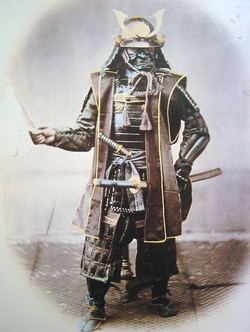
What is the Samurai code of Bushido? The
Samurai code of Bushido is the Japanese "way of the warrior", or Bushido {as it's also called.} Samurai Warrior Code was a strict code that demanded loyalty, devotion, obedience, duty, respect, self sacrifice, honor to the death, and filial piety.
Samurai code of Bushido is the Japanese "way of the warrior", or Bushido {as it's also called.} Samurai Warrior Code was a strict code that demanded loyalty, devotion, obedience, duty, respect, self sacrifice, honor to the death, and filial piety.
What does Feudal mean? Explain about the rigid class system in feudal Japanese society.
First, came the emperor. The Emperor and the imperial family "had the highest social status." He was a figurehead, a leader in name only. He was the religious leader, but had little political power, and in reality was under control of the shogun's clan.
Second, came the shogun: The shogun was part of the warrior class, and considered to be a noble. The shogun was the military leader of the most powerful Emperor's clan. The clans often fought to acquire this high social status. The shogun was the actual political ruler. He had a high social status and those of the other classes provided for his economic needs in return for protection and privileges (e.g., a small portion of land, some of the produce of the land).
Third, came the diamyos: The daimyos were a part of the warrior class. Daimyo translates to mean "great names." The daimyos were the shogun's representatives. They ran the estates according to the shogun's rules. Their swords were their most valuable possessions because they were required to use them often to demonstrate their loyalty to the shogun. They had high social status as members of the warrior class.
Fourth, came the samurai: The samuai were members of the warrior class. They were professional warriors of the military aristocracy. They were loyal to the shogun and daimyos, in whose castles they resided. Their position gave them fairly high social status, but little political power. Their economic needs were met by lower classes similar to the arrangement with the daimyos and the shogun.
Fifth, came the ronin: The ronin were paid soldiers whose loyalty was with the leader they defended at the time. The ronin were wandering samurai who had no daimyos. They worked as body guards for rich merchants or as paid soldiers during civil war. They had low social status, no political power and they depended on others for their economic well-being.
Sixth, came the peasants: The peasants were the largest class, constituting 90% of the population. The peasants included farmers and fishermen. They had very low social status, no political power and were very poor. They were valued because they produced the food for all other classes, and often made the material for clothing. The peasants paid taxes to the daimyos and shogun in the form of rice and work. Often peasants starved when they had to give up more than two-thirds of the year's crops to the upper classes in return for being able to remain on the land.
Seventh, came the artisans: The artisans were the craftspeople who made a variety of wood and metal products to meet the needs and wants of the other classes. The artisans made a variety of products including art, cooking pots, fish hooks, farm tools, utensils, ship anchors, and swords. The artisans, who were well-known for their exceptional swords, they were highly respected. However, on the whole, this class was not as respected as peasants because they did not produce food.
And finally, came the merchants: The merchants sold goods and produce made by others. The merchants were of very low social status and seen as unimportant because they produced nothing of value and lived off the efforts of others' work. They were extremly low respected, for these sellers that, often, they were made to live in separate locations, and not allowed to mix with other classes except to do business.
Why was Japan closed to outsiders? Foreigners (Westerners) during the experiences of Japanese Officials, seemed to have a habit of being dishonest. When these foreigners, for example might say, "...we only want to establish a trading base here...", the Japanese would later learn that a new city was being planned instead.When some foreigners might say, "...we only want to teach new religions here...", the Japanese would later learn that citizens were being forced to act certain ways or do certain things. Consequently in 1600 AD, Ieyasu Tokugawa (1543-1616), the first Shogun of Japan, established the "Shogunate Era" which "Isolated Japan" and lasted from 1600 until 1868, at which time Japan began to industrialize to meet the challenges of the 20th Century.
When it comes to religion in feudal Japan, explain about Buddhism and Shintoism. There are two dominant faiths in Japan: Buddhism and Shinto. Most Japanese follow traditions in both religions. Buddhism reached Japan in the 6th century and is derived from the teachings of the Buddha. Buddha means "one who has awakened." Anyone who "awakens" (by attaining Nirvana) becomes a buddha. Buddha's teachings are collected in sutras, which can be found in the "Tripitaka" (a compilation of documents relating to Buddhist tradition). Unlike Buddhism, Shinto has no recognized originator. It is sometimes said to be Japan's official religion because it developed in that country. Shinto tradition holds that the human race is descended from "kami" (deities that inhabit the rocks, trees, and other natural elements of Japan), so all humans are tied to nature.
First, came the emperor. The Emperor and the imperial family "had the highest social status." He was a figurehead, a leader in name only. He was the religious leader, but had little political power, and in reality was under control of the shogun's clan.
Second, came the shogun: The shogun was part of the warrior class, and considered to be a noble. The shogun was the military leader of the most powerful Emperor's clan. The clans often fought to acquire this high social status. The shogun was the actual political ruler. He had a high social status and those of the other classes provided for his economic needs in return for protection and privileges (e.g., a small portion of land, some of the produce of the land).
Third, came the diamyos: The daimyos were a part of the warrior class. Daimyo translates to mean "great names." The daimyos were the shogun's representatives. They ran the estates according to the shogun's rules. Their swords were their most valuable possessions because they were required to use them often to demonstrate their loyalty to the shogun. They had high social status as members of the warrior class.
Fourth, came the samurai: The samuai were members of the warrior class. They were professional warriors of the military aristocracy. They were loyal to the shogun and daimyos, in whose castles they resided. Their position gave them fairly high social status, but little political power. Their economic needs were met by lower classes similar to the arrangement with the daimyos and the shogun.
Fifth, came the ronin: The ronin were paid soldiers whose loyalty was with the leader they defended at the time. The ronin were wandering samurai who had no daimyos. They worked as body guards for rich merchants or as paid soldiers during civil war. They had low social status, no political power and they depended on others for their economic well-being.
Sixth, came the peasants: The peasants were the largest class, constituting 90% of the population. The peasants included farmers and fishermen. They had very low social status, no political power and were very poor. They were valued because they produced the food for all other classes, and often made the material for clothing. The peasants paid taxes to the daimyos and shogun in the form of rice and work. Often peasants starved when they had to give up more than two-thirds of the year's crops to the upper classes in return for being able to remain on the land.
Seventh, came the artisans: The artisans were the craftspeople who made a variety of wood and metal products to meet the needs and wants of the other classes. The artisans made a variety of products including art, cooking pots, fish hooks, farm tools, utensils, ship anchors, and swords. The artisans, who were well-known for their exceptional swords, they were highly respected. However, on the whole, this class was not as respected as peasants because they did not produce food.
And finally, came the merchants: The merchants sold goods and produce made by others. The merchants were of very low social status and seen as unimportant because they produced nothing of value and lived off the efforts of others' work. They were extremly low respected, for these sellers that, often, they were made to live in separate locations, and not allowed to mix with other classes except to do business.
Why was Japan closed to outsiders? Foreigners (Westerners) during the experiences of Japanese Officials, seemed to have a habit of being dishonest. When these foreigners, for example might say, "...we only want to establish a trading base here...", the Japanese would later learn that a new city was being planned instead.When some foreigners might say, "...we only want to teach new religions here...", the Japanese would later learn that citizens were being forced to act certain ways or do certain things. Consequently in 1600 AD, Ieyasu Tokugawa (1543-1616), the first Shogun of Japan, established the "Shogunate Era" which "Isolated Japan" and lasted from 1600 until 1868, at which time Japan began to industrialize to meet the challenges of the 20th Century.
When it comes to religion in feudal Japan, explain about Buddhism and Shintoism. There are two dominant faiths in Japan: Buddhism and Shinto. Most Japanese follow traditions in both religions. Buddhism reached Japan in the 6th century and is derived from the teachings of the Buddha. Buddha means "one who has awakened." Anyone who "awakens" (by attaining Nirvana) becomes a buddha. Buddha's teachings are collected in sutras, which can be found in the "Tripitaka" (a compilation of documents relating to Buddhist tradition). Unlike Buddhism, Shinto has no recognized originator. It is sometimes said to be Japan's official religion because it developed in that country. Shinto tradition holds that the human race is descended from "kami" (deities that inhabit the rocks, trees, and other natural elements of Japan), so all humans are tied to nature.
What are the countries and bodies of water around Japan?
The main countries around Japan are North and South Korea, and Russia. The main bodies of water around Japan are, the Pacific Ocean and the Sea of Japan also known as the East Sea.
The main countries around Japan are North and South Korea, and Russia. The main bodies of water around Japan are, the Pacific Ocean and the Sea of Japan also known as the East Sea.
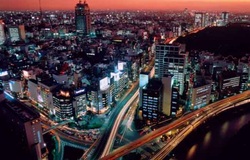
What are the four main islands around Japan?
The four main islands around Japan are Hokkaido, Honshu, Shikoku, and Kyushu.
The four main islands around Japan are Hokkaido, Honshu, Shikoku, and Kyushu.
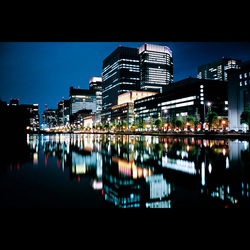
Interesting information about Tokyo.
Tokyo is also one of the 47 prefectures of Japan. But Tokyo is better known as the Metropolis of Tokyo. There are 23 wards and 62 municipalities in the Metropolis of Tokyo. The time zone of Tokyo is 9 hours ahead of Greenwich Mean Time.
Tokyo was previously known as Edo. It was renamed to Tokyo in the year 1867. Tokyo is situated in the Kanto region of Japan. It occupies an area of 2,187.08 sq km. The population of Tokyo according to the census of 2006 is 12,678,395. The density of population in Tokyo is 5796 per sq km.
Japanese is the official language of Tokyo. The literacy rate in Tokyo is about 99 %. The people of Tokyo follow the religions of Buddhism, Shinto and Christianity. Both Korean and Japanese people reside in Tokyo.
The Narita International Airport and Haneda Airport are two major airports in Tokyo. Tourists from outside Tokyo can avail flights from major airports of other countries to reach Tokyo. For tourists from countries like Canada, USA, France, Britain and Singapore staying in Japan upto 90 days do not require a visa to travel to Tokyo. Visas required to visit Tokyo can be obtained from the consulates and embassies of Japan.
The currency of Tokyo is Yen. Tourists visiting this city in Japan should carry descent amount of cash to make their payments at hotels and restaurants, as credit cards are not accepted by many organizations.
Other important facts about Tokyo are its emergency numbers. In case of emergency one can seek assistance from police by dialing 110. For ambulance and any hazard caused from fire, one can simply dial 119. These services are available 24 hours a day.
Tokyo is also one of the 47 prefectures of Japan. But Tokyo is better known as the Metropolis of Tokyo. There are 23 wards and 62 municipalities in the Metropolis of Tokyo. The time zone of Tokyo is 9 hours ahead of Greenwich Mean Time.
Tokyo was previously known as Edo. It was renamed to Tokyo in the year 1867. Tokyo is situated in the Kanto region of Japan. It occupies an area of 2,187.08 sq km. The population of Tokyo according to the census of 2006 is 12,678,395. The density of population in Tokyo is 5796 per sq km.
Japanese is the official language of Tokyo. The literacy rate in Tokyo is about 99 %. The people of Tokyo follow the religions of Buddhism, Shinto and Christianity. Both Korean and Japanese people reside in Tokyo.
The Narita International Airport and Haneda Airport are two major airports in Tokyo. Tourists from outside Tokyo can avail flights from major airports of other countries to reach Tokyo. For tourists from countries like Canada, USA, France, Britain and Singapore staying in Japan upto 90 days do not require a visa to travel to Tokyo. Visas required to visit Tokyo can be obtained from the consulates and embassies of Japan.
The currency of Tokyo is Yen. Tourists visiting this city in Japan should carry descent amount of cash to make their payments at hotels and restaurants, as credit cards are not accepted by many organizations.
Other important facts about Tokyo are its emergency numbers. In case of emergency one can seek assistance from police by dialing 110. For ambulance and any hazard caused from fire, one can simply dial 119. These services are available 24 hours a day.
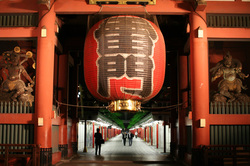
Natural Disasters that impact Japan
One disaster is a volcanic eruption. There are many volcanoes in Japan that are still live. A volcanic eruption can pour ash and lava all over the city. This can be a big disaster. Most of the buildings collapsed at one floor suffered from natural disasters in many of the buildings there was very little damage on the upper floors. (the city hospital in kobe showed lots of damage everywhere. the fifth floor of seven floors collapsed and 38 people got trapped between the floors.) buildings built on softer soil had greater damage. large steel-framed buildings worked better than any other type of building. The Japanese have built dikes which are large walls on the sand so that big waves can't wash out their city. During the earthquake in Kobe the dikes broke which flooded some areas.
One disaster is a volcanic eruption. There are many volcanoes in Japan that are still live. A volcanic eruption can pour ash and lava all over the city. This can be a big disaster. Most of the buildings collapsed at one floor suffered from natural disasters in many of the buildings there was very little damage on the upper floors. (the city hospital in kobe showed lots of damage everywhere. the fifth floor of seven floors collapsed and 38 people got trapped between the floors.) buildings built on softer soil had greater damage. large steel-framed buildings worked better than any other type of building. The Japanese have built dikes which are large walls on the sand so that big waves can't wash out their city. During the earthquake in Kobe the dikes broke which flooded some areas.

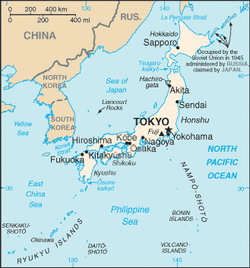
 RSS Feed
RSS Feed